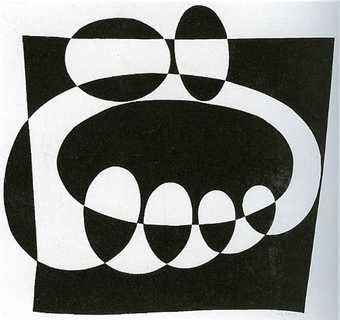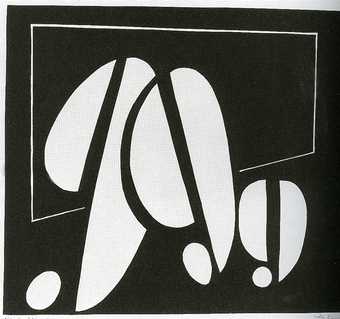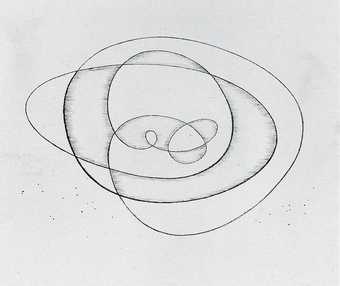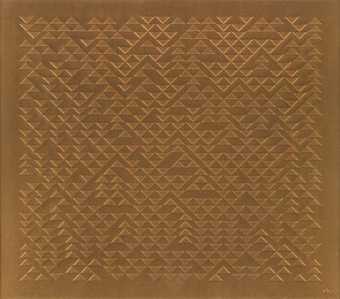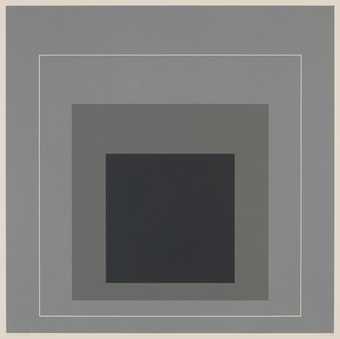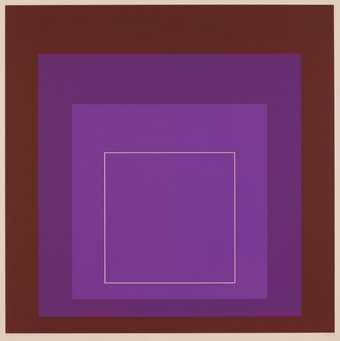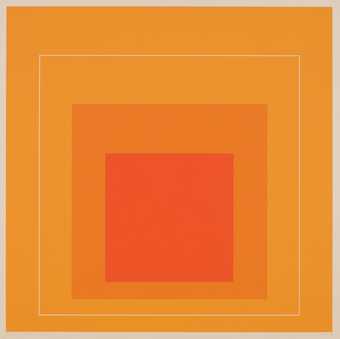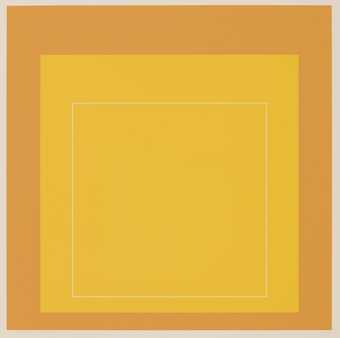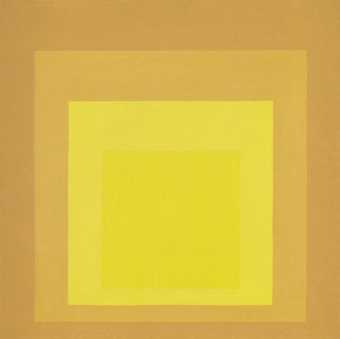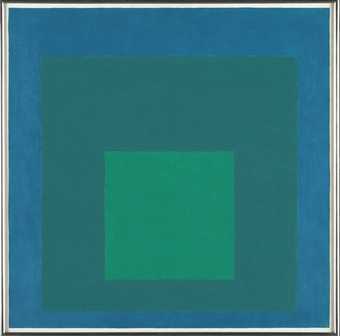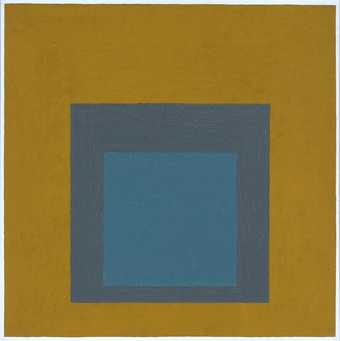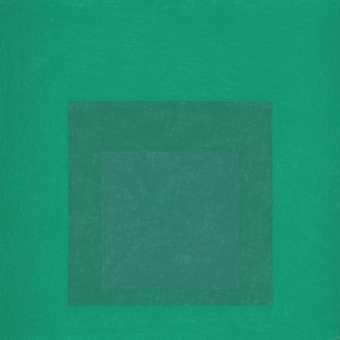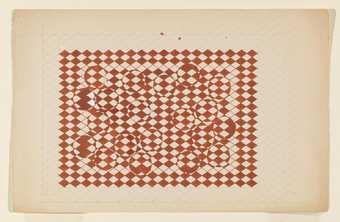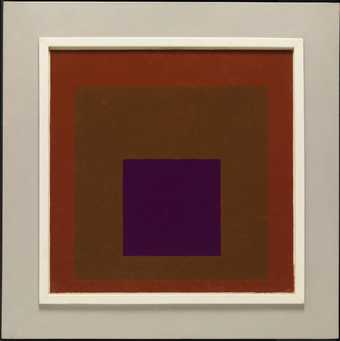
Not on display
- Artist
- Josef Albers 1888–1976
- Medium
- Lithograph on paper
- Dimensions
- Image: 400 × 400 mm
frame: 590 × 575 × 20 mm - Collection
- Tate
- Acquisition
- Presented by the Museum of Modern Art, New York 1976
- Reference
- P01786
Summary
White Line Square IV is a lithographic print on paper comprising interlocking squares of decreasing size printed in three colours, with a fine line set among them that remains un-inked. A large brown square dominates the image, inside which sits the pale outline of a square, which itself contains a further brown square. Inside this smaller brown square is a greyish-red square, which is inhabited by a further, smaller square in a deeper red colour. Each square frames the next one evenly, so that the composition and its colours appear balanced and symmetrical. The coloured elements are contained within a border of un-inked paper, and the fine outline of the square within the brown, which is also un-inked, is of a similar tone to the support, although it appears slightly darker due to the influence of the coloured areas directly either side of it. This print is edition number 86 of a total of 125.
Josef Albers designed and produced this lithograph in 1966 with the assistance of the Los Angeles print workshop Gemini G.E.L. (Graphic Editions Limited). At the lower left of the print, handwritten in graphite pencil, is the abbreviated title of the work followed by the edition number and total number of editions (‘WLS IV 86–125’). At the lower right of the print, again handwritten in pencil, is Albers’s monogram and the year of production. This series of prints was one of the first produced by Gemini G.E.L., which had been founded that same year. Three separate aluminium plates were used by the workshop to create the work. Firstly, the smallest, central square was printed onto a sheet of Arches Cover paper using deep red ink. Secondly, the middle tone square, in greyish-red, was applied to the paper. Finally, the outer square was printed with umber-brown, and the plate for this colour featured a thin slot or recess that generated the work’s ‘white line’ when the ink was applied. Although the print appears to be a set of three overlapping squares, each printing plate covered the precise area in which it appears to the viewer. This ensured that each colour remained pure and vibrant, rather than the muddying effect that would have occurred had the printed squares overlapped each other. This choice of technique meant that the accurate manufacture and precise registration of each of the printing plates was critical, to prevent overlap or mismatch in each phase of the printing process.
Albers produced a total of seventeen schemes for White Line Square. The variants were numbered I to XVII and all were published in 1966 and 1967. The White Line Square series built on Albers’s earlier exploration of arrangements of colour, in particular his Homage to the Square series of oil on fibreboard paintings that he began in 1950 and with which he continued to experiment until his death in 1976 (see, for instance, Study for Homage to the Square: Departing in Yellow 1964, Tate T00783).
In 1963 Albers published his treatise Interaction of Color, which explained his theory of relational colour in art (see Josef Albers, Interaction of Color, revised edn, New Haven and London 2006). However, the White Line Square series of prints was a means of experimenting with and proving a further colour theory proposed by Albers: that a thin white line that splits a single solid colour will create the effect that the hue and/or saturation at each side of the fine white line differs. In 1966 Albers explained this effect as follows:
When the line is placed within a so-called ‘Middle’ color, even when the color is very evenly applied, it will make the one color look like two different shades or tints of that color. Such white lines dividing a color area are presented (probably for the first time) in the ‘White Line Squares’ lithographs.
(Albers 1966, p.19.)
Born in Bottrop, Germany, Albers and his wife Anni taught at the Bauhaus in Dessau until its closure in 1932, leaving Germany the following year to escape the difficult political situation and moving to North Carolina to teach at the influential Black Mountain College. Albers’s work and his theories of colour had a major impact on the artists of the following generations, as curator and art historian Diane Waldman has stated: ‘The work of other artists like Donald Judd, Frank Stella and Sol LeWitt – indeed many of the Minimalists of the 1960s – owes much to Albers’s theories and the example of his painting, engraved plastics and prints.’ (Waldman in Josef Albers: A Retrospective, exhibition catalogue, Solomon R. Guggenheim Museum, New York 1988, p.12.)
Further reading
Josef Albers, ‘White Line Squares’, in Josef Albers: White Line Squares, exhibition catalogue, Los Angeles County Museum of Art and Gemini G.E.L., Los Angeles 1966, pp.19–20.
Henry T. Hopkins, ‘The New Lithographs’, in Josef Albers: White Line Squares, exhibition catalogue, Los Angeles County Museum of Art and Gemini G.E.L., Los Angeles 1966, pp.33–4.
Brenda Danilowitz, The Prints of Josef Albers: A Catalogue Raisonné, 1915–1976, New York 2010, p.114, reproduced p.116.
Pete Gubbins
December 2016
Supported by the Terra Foundation for American Art.
Does this text contain inaccurate information or language that you feel we should improve or change? We would like to hear from you.
Explore
- abstraction(8,615)
-
- non-representational(6,161)
- formal qualities(12,454)
-
- symmetry(220)
You might like
-
Josef Albers Circle
1933 -
Josef Albers Homeward
1933 -
Josef Albers Beta
1939 -
Anni Albers TR III
1969–70 -
Josef Albers White Line Square III
1966 -
Josef Albers White Line Square IX
1966 -
Josef Albers White Line Square XI
1966 -
Josef Albers White Line Square XII
1966 -
Josef Albers White Line Square XV
1966 -
Josef Albers Study for Homage to the Square: Departing in Yellow
1964 -
Josef Albers Study for Homage to the Square: Beaming
1963 -
Josef Albers Study for Homage to the Square
1963 -
Josef Albers Study for Homage to the Square
1964 -
Josef Albers Untitled Abstraction V
c.1945 -
Josef Albers Homage to the Square: Study for Nocturne
1951

